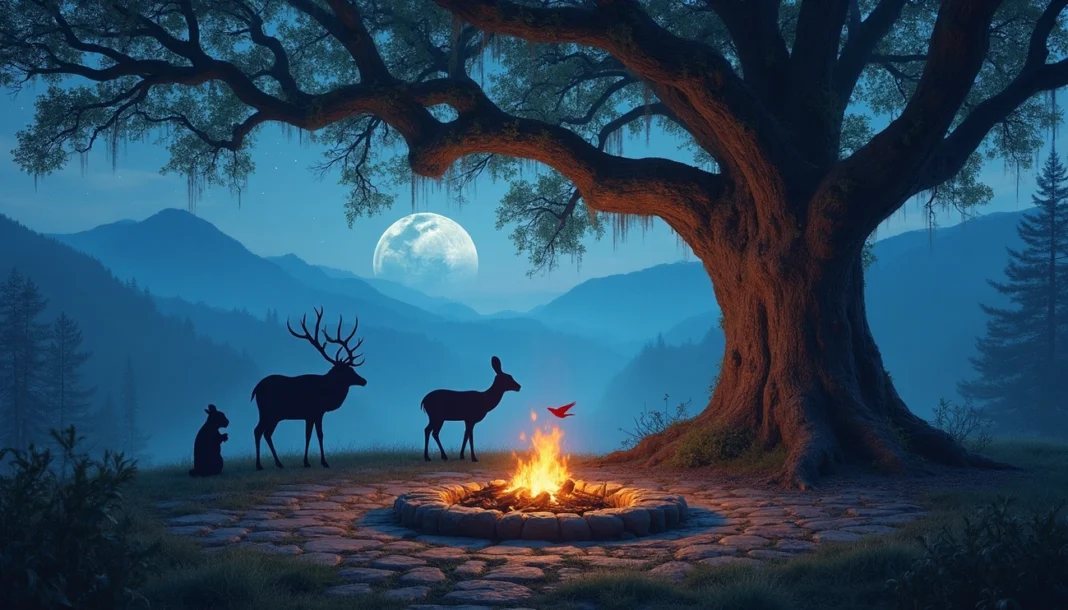Cherokee myths are a cultural treasure of Native American heritage. These ancient stories give us a unique look into the Cherokee people’s worldview, values, and spiritual beliefs. Tribal members and ethnographers carefully documented these narratives in the early 1900s, preserving stories that had been passed down orally for generations.
Cherokee mythology played many vital roles in the tribe’s life. The folklore taught moral lessons and preserved tribal history while explaining natural phenomena. The tribe’s creation myths tell how the world emerged from primordial waters. Their animal tales feature clever rabbits and wise owls. These stories are the foundations of Cherokee’s spiritual understanding. The tribe’s stories about supernatural beings and spirit realms show their deep beliefs about how physical and spiritual worlds connect. Yes, it is remarkable that Cherokee myths and legends appeal to people today and give an explanation of indigenous wisdom that existed long before European contact.
Cherokee Creation Myths and Cosmogony
Image Source: American Indian COC
Cherokee myths revolve around a complex cosmology that explains the universe’s origins. These sacred stories passed down through generations help people understand the Cherokee worldview and their connection with nature.
How the World Was Made
The Cherokee people believed Earth was a great floating island surrounded by endless water. Their creation story tells us all animals lived in Galun’lati, a place beyond the stone arch of the sky. The animals needed more space as their realm became crowded. They wanted to know what existed beneath the waters. Water Beetle stepped forward to explore and dove deep to bring up mud that grew into earth. Four cords at the cardinal points secured the land to the sky to keep it from sinking back into the ocean. The Great Buzzard flew over the soft earth, and his wings carved out valleys where they struck the ground. Mountains rose where his wings turned upward – creating the unique landscape of the Cherokee homeland.
The First Fire and the Origin of Light
The world stayed cold without fire. The Thunders who lived in Galun’lati placed fire in a hollow sycamore tree on an island. The animals saw the smoke but couldn’t reach it. They gathered for a council where many volunteered to get the fire. Raven made the first attempt but came back with scorched feathers. Screech Owl tried next and ended up with red burned eyes. Water Spider succeeded after many failed attempts. She spun a thread from her body and wove a small bowl to carry on her back. The Middle World got fire forever after she crossed to the island and brought back a coal of fire in her bowl.
Kana’tï and Selu: The First Hunters and Farmers
Kana’tï (The Lucky Hunter) and Selu (Corn) provided for everyone. Kana’tï kept all game animals in a cave and released them one at a time for food. Selu used her magical powers to produce corn and beans from her body. Their curious sons found these secrets and let all the animals loose, which forced humans to hunt throughout the forests. The boys killed Selu because they thought she was a witch. Before dying, she told them to drag her body across cleared ground seven times. Corn started growing wherever her blood touched the earth, and this began agriculture.
The Origin of Disease and Medicine
Humans grew in numbers and moved into animal territories to hunt them. The animals felt threatened and created diseases to control the human population. The plants stayed friendly to humans and offered cures for each disease. This story explains why every plant has healing properties – to balance the animals’ revenge.
Animal Myths in Cherokee Folklore
Animals serve as both teachers and tricksters in Cherokee mythology. Their stories show how the Cherokee people made sense of animal behavior through creative storytelling.
The Rabbit and the Tar Wolf
A severe drought forced animals to hold council. They agreed that only those who helped dig a well could drink from it. The lazy Rabbit refused to help because he preferred chasing female rabbits. The animals soon found water and suspected Rabbit was stealing from their well at night. Wolf and Fox created a clever trap – a sticky figure that looked like a wolf made from tar. Rabbit came at night and got stuck when he touched the figure. The animals threatened various punishments before deciding to throw him into a briar patch. This patch became his perfect home, which explains why rabbits today run in zigzag patterns.
Why the Possum’s Tail Is Bare
The Possum once had a beautiful bushy tail that he combed each morning. His constant bragging annoyed other animals, especially Rabbit who had no tail. Rabbit made a plan and arranged for Cricket, known as “the barber,” to prepare Possum’s tail before a grand council meeting. Cricket secretly cut off all the fur and wrapped the tail in red ribbon while Possum relaxed with closed eyes. The animals burst into laughter at the dance when Possum proudly unwrapped his tail. The embarrassed Possum fell over and “played dead” – a behavior that possums still show today.
How the Deer Got His Horns
Deer had no horns in the beginning. The animals organized a race between Deer and Rabbit to award a magnificent pair of antlers. Rabbit cheated by clearing a secret path through the thicket before the race. The animals discovered his deception and gave the horns to Deer, the honest runner. They also punished Rabbit by making him spend his life gnawing twigs and bushes.
The Terrapin’s Escape from the Wolves
Terrapin and Possum went gathering persimmons one day. Terrapin cleverly made a wolf choke to death and used the wolf’s ears as spoons. The wolves captured Terrapin after hearing about this deed. They discussed different ways to kill him. Terrapin claimed he would break the pot if boiled and put out the fire if burned. The wolves decided to drown him – exactly what Terrapin wanted. He pretended to beg for mercy, and the wolves threw him into deep water. Terrapin escaped by swimming away.
Bird and Insect Stories from the Mountains
Image Source: Ya-Native
Birds and insects hold special places in Cherokee mythology. These creatures teach timeless lessons about working together, pride, and showing respect to all living things. The stories come from the Smoky Mountain region and show how the Cherokee people watched nature closely.
The Ball Game of the Birds and Animals
The animals once challenged the birds to a big ball game. A mighty bear led the animal team and bragged about his strength. The swift deer and tough-shelled terrapin joined him. The eagle, who led the birds, worried about winning. Two tiny creatures came to the birds after the animals turned them away for being too small. The birds had a clever idea – they made wings for the bat from drum leather and stretched the flying squirrel’s skin between his legs. These new teammates turned the game around. The bat dodged so well and the flying squirrel moved so smoothly that the birds beat their stronger rivals. The story shows us that smart thinking beats raw power.
How the Redbird Got His Color
The redbird started out plain brown. One day he found a wolf with mud stuck in his eyes from a playful raccoon’s prank. The kind bird carefully picked away the mud until the wolf could see again. The grateful wolf wanted to give the bird a gift and said that even though the bird helped him, his looks were plain. He took the bird to a rock with red paint clay and colored his feathers bright red. The mother redbird rushed back to feed her babies and got only partly colored – that’s why female cardinals look less red than males.
Why the Buzzard’s Head Is Bare
The buzzard used to have beautiful head feathers and thought he was too good to eat dead animals. His pride annoyed the other animals so much they made a plan against him. The buzzard lost his fancy topknot and almost all his head feathers. This taught him a lesson, and from then on, he ate whatever he could find – which explains his bare head and eating habits today.
The Katydid’s Warning
Two hunters made camp in the forest and heard a katydid singing nearby. One hunter made fun of it, saying it would die before summer ended. The katydid spoke back and told him he would die before the next night. The next day, enemies attacked and killed the rude hunter – teaching everyone that we should respect even the smallest creatures.
Wonder Tales and Spirit Legends
Image Source: Hangar 1 Publishing
The spiritual realm plays a vital role in Cherokee myths, where powerful beings weave their way through human lives in mysterious ways.
Ûñtsaiyï, the Gambler and the Spirit World
Ûñtsaiyï created the gatayûstï game played with stone wheels and sticks. This notorious gambler lived near Ûñ’tiguhï’ on the Tennessee River, where whirlpools churned like boiling pots. The crafty Ûñtsaiyï ended up facing his match when Thunder’s son challenged him. Thunder gave his son a magical gourd filled with endless beads, and the boy defeated Ûñtsaiyï again and again. After losing everything—including his life—Ûñtsaiyï tried to escape. A Green Beetle helped catch him by seeing through his disguises. The brothers drove a stake through his chest at the world’s western edge, where he still struggles beneath the waters today.
The Spear-Finger and the Stone Man
Spear-Finger (U’tlun’ta) struck fear with her stone-like skin and obsidian finger that could extract victims’ livers. She prowled eastern Tennessee and western North Carolina, and loved walking between Chilhowee Mountain and the Little Tennessee River. Her shapeshifting powers let her appear as a trusted grandmother to trick children. Cherokee warriors trapped her in a pit after many deaths. Their attempts to kill her failed until a tiny chickadee revealed her secret—her heart lay hidden in her right palm. The warriors used this knowledge to defeat her.
The Enchanted Lake of Atagâ’hï
Atagâ’hï (“Gall place”), a mystical lake, lies deep in the Great Smoky Mountains. People can see it only through fasting and prayer. Hunters might hear thousands of wild ducks nearby but find just dry ground. Animals use the lake as medicine—wounded bears dive into its purple waters and come out healed. The Cherokee know about this lake, but sacred waters remain hidden from most eyes.
The Nûñnë’hï: Spirit Folk of the Mountains
The Nûñnë’hï (“People Who Live Anywhere”) made their homes in mountain townhouses throughout Cherokee lands. These immortal beings stayed invisible unless they chose to show themselves. They sometimes invited Cherokee to join them, like at Nottely where four Nûñnë’hï women danced with young men before vanishing at the river. The Nûñnë’hï protected the Cherokee by warning them of danger and fighting beside them against enemies. Some Cherokee joined these spirits inside the mountains to escape the trail of tears during the Removal of 1838.
The original Cherokee myths from 1900 manuscripts show deep wisdom about how humans connect with nature and the spiritual world. These stories are without doubt the life-blood of their culture and explain everything from how the universe began to why animals behave as they do. Their creation stories paint a picture of a world floating in ancient waters, while the tales of Kana’tï and Selu link Cherokee people to their farming and hunting heritage.
Animal stories entertain but also cleverly teach moral lessons. Rabbits use trickery, possums show vanity, and deer display honor – all mirror human strengths and weaknesses. Like in bird and insect stories, they show how Cherokee people believed even the tiniest creatures had wisdom and played their part in nature’s grand design.
Spirit legends are the most important part of Cherokee beliefs about the universe. Mighty beings like Spear-Finger and the Nûñnë’hï show how thin the line is between our world and the spirit world. The magical lake of Atagâ’hï, which only the spiritually ready can see, shows how sacred places shaped Cherokee spiritual practices.
These stories mean much more than just entertainment. They form a complex system that passed down tribal history, explained nature’s mysteries, taught moral lessons, and helped keep spiritual wisdom alive through generations. Modern readers can now peek into pre-colonial indigenous wisdom through these preserved manuscripts – wisdom that could have been lost forever.
Cherokee mythology gives us timeless lessons about living in harmony with nature, respecting all creatures whatever their size or might, and seeing how physical and spiritual worlds connect. These stories still appeal to people today because they tackle basic questions about who we are, how we fit into nature, and where we belong in the universe. Their ancient wisdom manages to keep surpassing cultural and historical boundaries.






